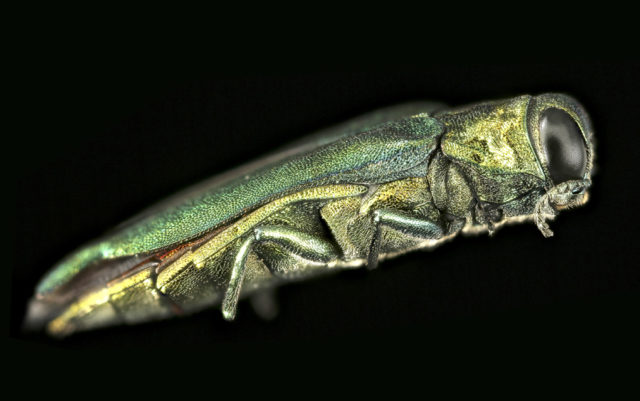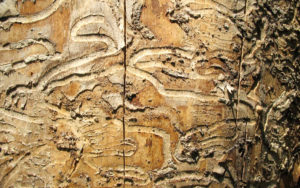
Longmont is joining Boulder in a hotter future, with more pollution and potentially worse floods at the hand of a tiny, jewel-colored insect.
The emerald ash borer, glittering green and smaller than a penny, is said to be the most destructive tree pest in North American history. In urban areas near where the invasive species first touched down in the U.S. in 2002, nearly 100 percent of ash trees have been wiped out.
“The urban tree canopy overall provides huge environmental, social, economic benefits to the community,” says Kathleen Alexander, City of Boulder forester, “everything from shading and saving energy, reducing the need for air conditioners to carbon sequestration, carbon storage, reducing the flood risk for the city.”
Trees also essentially breathe in pollutants and gather particulate matter on their leaves, keeping them out of our lungs. They save 850 lives a year in the U.S., as well as preventing 670,000 cases of acute respiratory illness and saving $7 billion in health costs, according to the U.S. Forest Service.
But wherever emerald ash borers go, ash trees die. Tens of millions of trees have been lost since the borer reached the U.S. from Asia almost 15 years ago. Landing first in Michigan, they have now spread to 25 states and two Canadian provinces.
And as of June 6, they were discovered in Longmont. Evidenced by the damage they’ve already caused, it’s believed borers have been there for at least two years, but so far they appear to be localized in a single neighborhood, near Ninth Avenue and Hover Street, close to Golden Ponds Park.
“The good news is we haven’t found it anywhere else yet,” says Ken Wicklund, Longmont forestry supervisor. “I don’t know if good news is the right word there cause it moves so quickly … We can presume that it’s in more parts of the city than just that one neighborhood, but it’s really difficult to detect this thing early on.”
Emerald ash borers were first found in Colorado in 2013 in the City of Boulder and hadn’t shown signs of spreading until now. But that doesn’t mean they haven’t.
“The way this insect works is that it goes undetected early on and you really can’t see the symptoms, but the beetle’s doing its business in the tree,” Wicklund says.
Females lay 40 to 70 eggs at a time and can have as many as 200 in their lifetime. Wicklund says their prolific breeding and ability to spread quickly is what makes the invasive insect so deadly.
Borers’ larvae live beneath the bark of ash trees, burrowing in meandering S-shaped tunnels and cutting off the tree’s supply of nutrients and water.

Longmont has a plan to treat 900 trees on public land and remove low-quality trees, replacing them with other species. But of the 37,800 ash trees in Longmont, 35,000 are on private land; meaning homeowners are responsible for treating and/or removing infected trees.
“We have more eyes looking than ever,” Wicklund says. “We have contractors looking as they prune trees, our own staff is looking as we’re working on the ash trees, and we’re getting a lot of calls from citizens.”
But what citizens report most often are another insect called a lilac ash borer.
“Emerald ash borer is basically a tree killer,” Wicklund says, “But lilac ash borer can stress out portions of the tree and it can give some symptoms that are similar to emerald ash borer.”
Lilac ash borers appear wasp-like. They leave larger exit holes that aren’t D shaped and tend to single out portions of the tree rather than killing the whole thing.
Alexander suggests property owners consult local certified arborists to determine the best course of action. Pesticides are expensive and have to be administered by a professional throughout the life of the tree. The cheaper option is to remove and replace infested ash trees, which can still cost up to a thousand dollars.
The City of Boulder has a goal of planting 500 new trees a year. Boulder spent $128,000 on the emerald ash borer last year between planting new trees, pesticide treatments, tree removal and debris management. The City anticipates increased tree removal to raise this year’s cost by $40,000 based on the number of dead trees.
“Economically, it’s gonna cost a lot to deal with emerald ash borer,” Alexander says. “Not just for the City of Boulder, but Longmont, Denver, every community out there. Ash makes up a big component of our urban forests here along the Front Range.”
Wicklund says it’s nearly impossible to eradicate the insect. The best chance we have for keeping costs down and minimizing the damages of lost trees is detecting infestations early and planting new trees to take the place of our ash, which will inevitably succumb to the emerald ash borer.














